Perennials
Showing 17–26 of 26 results
-
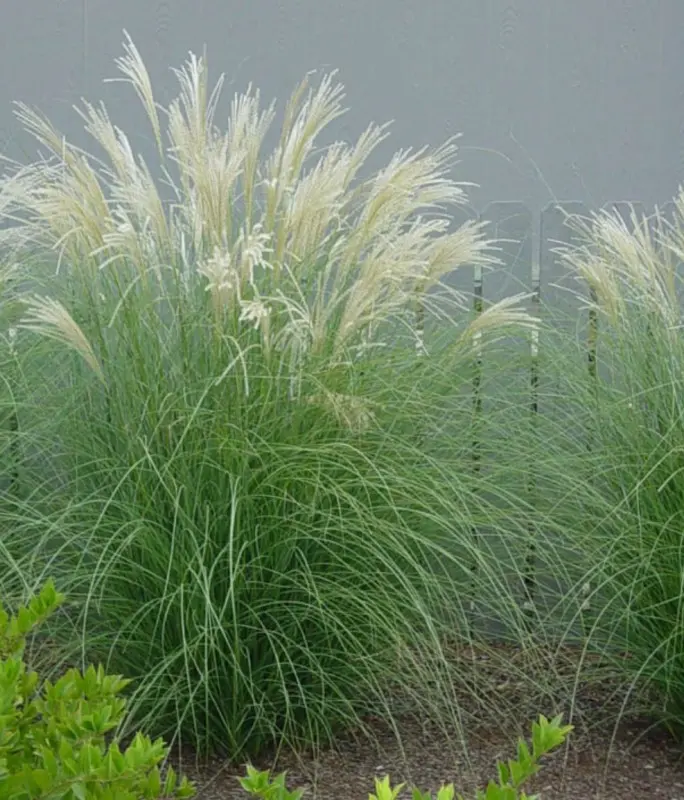
Maiden Grass
$0.00Add to Lawn3'-5'Full sunPartial sunNot deer resistantMaiden Grass (Miscanthus sinensis), also known as Chinese Silver Grass, is a graceful, clump-forming ornamental grass celebrated for its feathery, fan-like plumes and slender, arching foliage. Native to Asia, Maiden Grass creates a soft, airy presence in the landscape, with tall stems that can reach 4 to 8 feet, topped by attractive silvery or pink-tinged flower plumes in late summer to early fall. As the seasons change, the foliage transitions from green to a golden tan, offering year-round interest. Maiden Grass thrives in full sun to partial shade and is hardy in USDA zones 5-9. It prefers well-draining soil and is moderately drought-tolerant once established. The plant’s tall, upright habit and flowing form make it ideal for borders, privacy screens, and mass plantings. Its structure and movement add dynamic visual appeal, especially when the plumes catch sunlight or a gentle breeze. Beyond its beauty, Maiden Grass is low maintenance, requiring minimal care aside from an annual pruning in late winter to clear away dead stems and encourage new growth. In colder regions, its dried foliage and plumes provide texture and interest throughout the winter. For gardeners looking for a versatile, eye-catching plant with a naturalistic feel, Maiden Grass is an excellent choice for enhancing landscapes with height, texture, and seasonal color. -
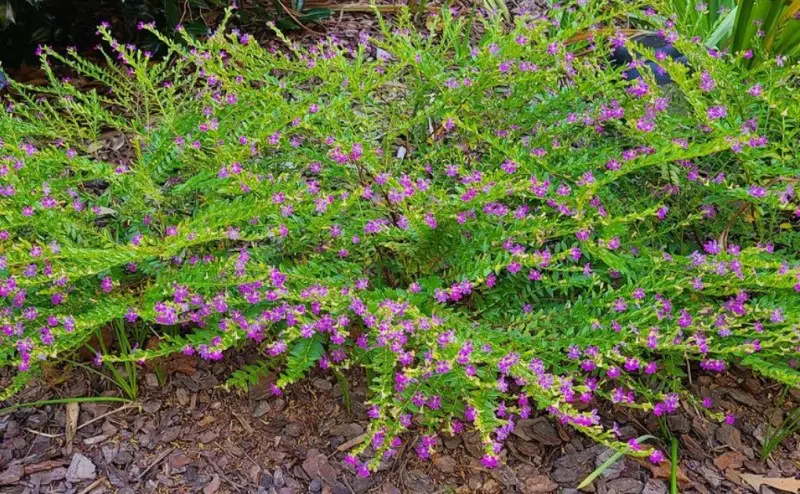
Mexican Heather
$0.00Add to Lawn1'-3'Full sunPartial sunNot deer resistantMexican Heather (Cuphea hyssopifolia) is a charming, low-growing shrub admired for its delicate, evergreen foliage and profusion of tiny, tubular flowers. Originating from Mexico and Central America, this plant blooms nearly year-round in warmer climates, showcasing colors like purple, lavender, white, and pink. Mexican Heather’s flowers, while small, are plentiful and add vibrant splashes of color that make it an ideal choice for borders, ground cover, or container gardens. The plant typically reaches a height and spread of 1 to 2 feet, forming a neat, bushy mound. It prefers full sun to partial shade and thrives in USDA zones 9-11, though it can be grown as an annual in cooler climates. Mexican Heather is drought-tolerant once established and requires well-draining soil to avoid root rot. In high-heat areas, a bit of afternoon shade can help prevent stress and maintain foliage health. Because of its compact size and resilient nature, Mexican Heather is popular for both formal and informal garden settings. It attracts pollinators like bees and butterflies and adds a soft, lacy texture to mixed plantings. Light trimming can keep it tidy, though it generally requires minimal pruning to maintain its shape. With its hardiness and adaptability, Mexican Heather makes a versatile and low-maintenance choice for adding enduring color and structure to landscapes. -

Mexican Sage
$0.00Add to Lawn2'-3'Full sun-Deer resistantMexican Sage (Salvia leucantha), also known as Mexican Bush Sage, is a beloved perennial shrub valued for its velvety, silver-green foliage and showy spikes of purple and white or lavender flowers. Native to Mexico and Central America, this sage blooms from late summer through fall, adding rich color to gardens when many other plants have faded. The flowers are long-lasting, tubular, and emerge on tall, arching stems, making Mexican Sage especially attractive to pollinators like hummingbirds, butterflies, and bees. Mexican Sage grows to about 3 to 4 feet in height and width, forming a dense, bushy mound that works well in borders, mass plantings, or as a striking focal point. It thrives in full sun and is hardy in USDA zones 8-11, though it can be grown as an annual in cooler climates. This plant prefers well-draining soil and is drought-tolerant once established, making it ideal for low-water or xeriscape gardens. While it can handle occasional watering, overly wet conditions should be avoided to prevent root rot. Low-maintenance by nature, Mexican Sage benefits from occasional pruning to encourage bushier growth and to remove spent blooms. Its resilience, vivid color, and attraction to pollinators make it a favorite for adding a natural, wildflower look to landscapes. Mexican Sage’s vibrant hues and soft, fuzzy texture bring a unique visual and tactile appeal to gardens, providing color and interest well into the autumn months. -
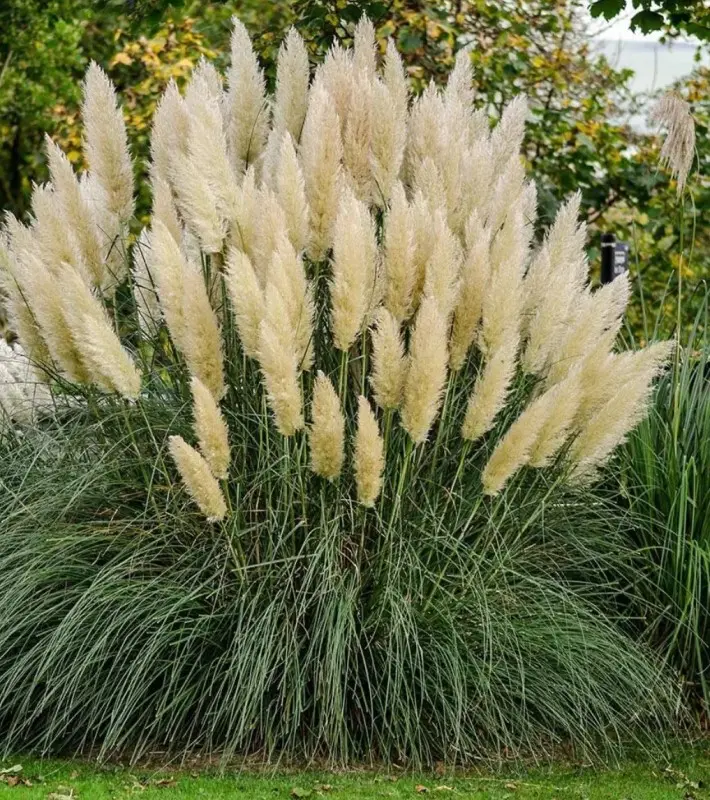
Pampas Grass
$0.00Add to Lawn5'-10'Full sun-Not deer resistantPampas Grass (Cortaderia selloana) is a robust ornamental grass known for its towering plumes and lush, fountain-like foliage. Originating from South America, this striking grass is valued for its tall, arching stems and dramatic white or pink feathery plumes that can reach up to 10 feet in height, blooming from late summer to fall. The plumes are soft, fluffy, and durable, making Pampas Grass a favored choice for both landscape design and dried floral arrangements. Pampas Grass is typically hardy in USDA zones 7-11 and performs best in full sun with well-draining soil. It is drought-tolerant once established and can adapt to a variety of soils, including sandy and coastal areas, where its salt tolerance is beneficial. However, in colder zones, Pampas Grass may need winter protection or be treated as an annual. Its clumps can spread widely, often reaching 3 to 6 feet in diameter, so ample space is recommended. Popular as a statement plant in large gardens or along borders, Pampas Grass adds height and texture, complementing other low-growing perennials and shrubs. It is a low-maintenance plant, though some pruning of dead foliage in late winter can help promote fresh spring growth. Due to its vigorous nature, Pampas Grass can be invasive in certain areas, so it is essential to check local guidelines before planting. For those seeking an architectural, show-stopping addition, Pampas Grass brings both beauty and boldness to landscapes. -
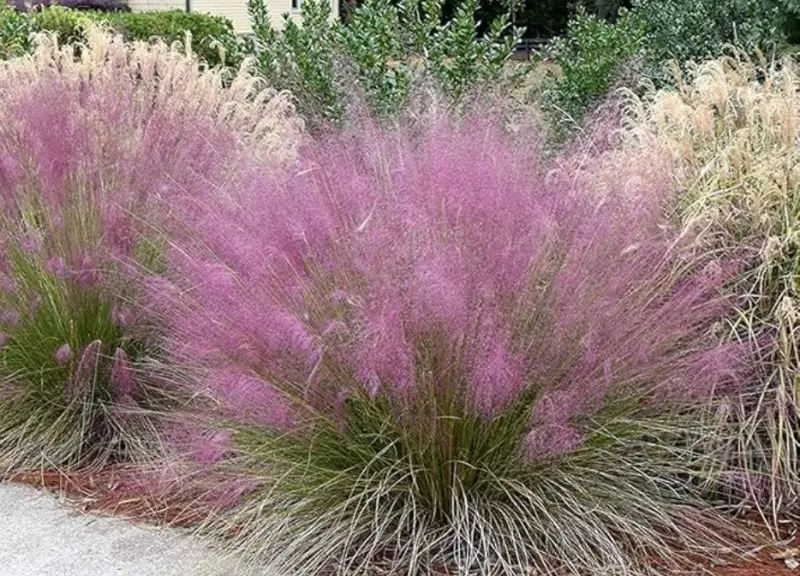
Pink Muhly Grass
$0.00Add to Lawn2'-3'Full sunPartial sunNot deer resistantPink Muhly Grass (Muhlenbergia capillaris) is an ornamental grass renowned for its dramatic, cotton candy-like plumes that emerge in shades of pink to pinkish-purple. Native to North America, this striking grass provides a breathtaking display in the fall when its airy, feathery blooms create a cloud of pink over the plant’s fine, green foliage. Pink Muhly Grass typically reaches a height and width of 2 to 3 feet, forming neat, rounded clumps that add soft texture and color to landscapes. Thriving in full sun, Pink Muhly Grass is hardy in USDA zones 6-10 and is highly adaptable to a variety of soils, including sandy and rocky soils, as long as they are well-draining. This grass is also drought-tolerant and can withstand heat and humidity, making it an excellent choice for low-maintenance, water-wise gardens. Its vibrant color and light, airy texture make Pink Muhly Grass ideal for mass plantings, borders, and as a focal point in mixed garden beds. Once the blooms fade in winter, the grass still maintains its structure, providing winter interest until it can be pruned back in early spring to encourage fresh growth. Pink Muhly Grass brings a unique and eye-catching element to landscapes, adding a soft, ethereal quality that is especially striking when planted in large groups or as a contrast against darker foliage. -

Purple Fountain Grass
$0.00Add to Lawn3'-5'Full sunPartial sunNot deer resistantPurple Fountain Grass (Pennisetum setaceum 'Rubrum') is a popular ornamental grass admired for its dramatic purple to burgundy foliage and graceful, arching plumes. This warm-season grass, native to Africa and southwestern Asia, is known for its elegant, fountain-like form and vibrant color, making it a standout in garden landscapes. The soft, feathery plumes, which appear in late summer and persist into fall, range from pinkish-purple to deep red, adding both movement and texture to the landscape. Purple Fountain Grass grows to about 3 to 5 feet tall and 2 to 4 feet wide, forming dense clumps that maintain their shape through the growing season. This plant prefers full sun and is hardy in USDA zones 9-11, though it is often grown as an annual in cooler climates. It thrives in well-draining soil and has moderate drought tolerance once established, making it suitable for water-wise gardens. The grass’s deep purple hues pair well with various perennials, flowering shrubs, or contrasting greenery, creating eye-catching displays in borders, containers, and mass plantings. Low maintenance by nature, Purple Fountain Grass benefits from cutting back in late winter or early spring to promote fresh growth. With its cascading plumes and rich colors, Purple Fountain Grass adds a striking, dynamic element to landscapes and is highly valued for its adaptability and beauty. -
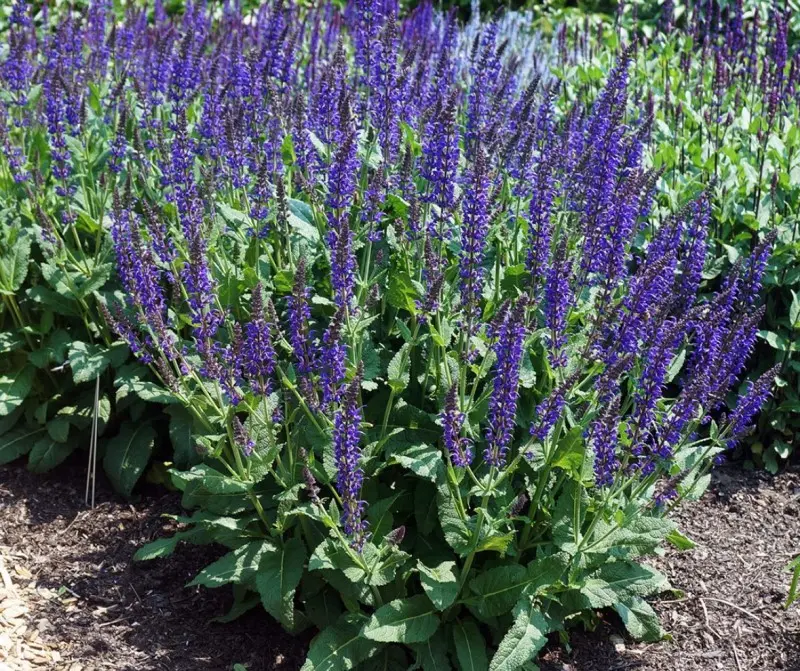
Salvia
$0.00Add to Lawn2'-3'Full sun-Deer resistantSalvia (Salvia spp.), commonly known as Sage, is a versatile genus of perennial plants celebrated for its vibrant, tubular flowers and aromatic foliage. With over 900 species, Salvia blooms in a range of colors, including shades of blue, purple, red, pink, and white, making it a favorite for adding rich color and structure to gardens. Highly attractive to pollinators such as bees, butterflies, and hummingbirds, Salvia brings life and movement to landscapes. Salvia plants typically reach heights of 1 to 4 feet, depending on the species, and have an upright, bushy form. Thriving in full sun, Salvia is generally hardy in USDA zones 5-11, though hardiness varies by variety. The plant prefers well-draining soil and is drought-tolerant once established, making it ideal for water-wise or xeriscape gardens. Popular varieties include Scarlet Sage (Salvia splendens), known for its striking red flowers; Mealycup Sage (Salvia farinacea), with its blue blooms suited to warm climates; Autumn Sage (Salvia greggii), which displays red or pink flowers and thrives in hot, dry regions; and Woodland Sage (Salvia nemorosa), a hardy perennial with purple blooms for cooler climates. Low-maintenance and resistant to deer and pests, Salvia requires only occasional deadheading to encourage continuous blooming and a light pruning in early spring for a bushier appearance. Perfect for borders, cottage gardens, and containers, Salvia adds fragrance, color, and ecological value to the garden throughout the growing season. Its vibrant flowers, aromatic leaves, and pollinator-friendly nature make Salvia a versatile and rewarding addition to a variety of garden settings. -
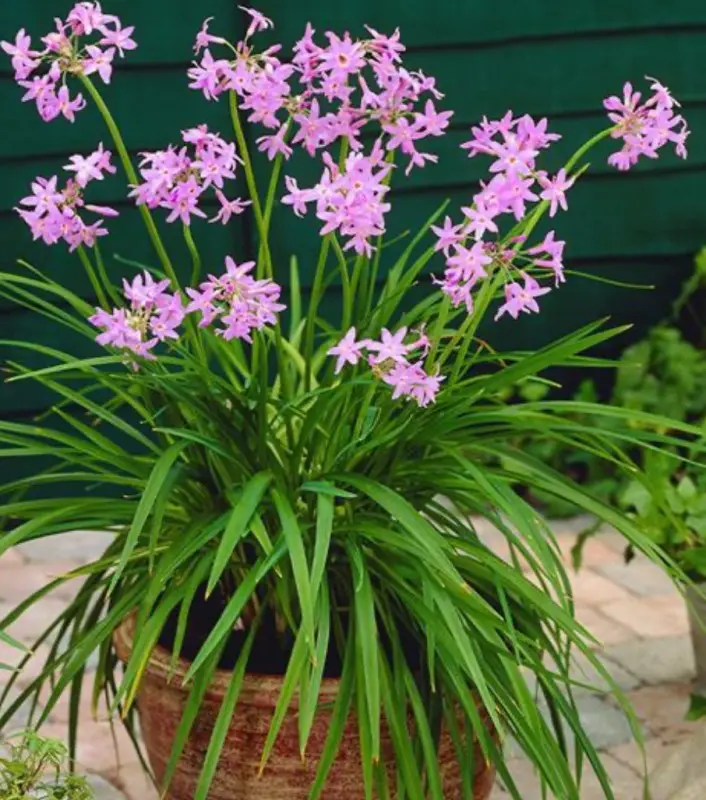
Society Garlic
$0.00Add to Lawn1'-2'Full sunPartial sunDeer resistantSociety Garlic (Tulbaghia violacea) is a hardy, clump-forming perennial known for its delicate, lavender-pink flowers and garlic-scented, grass-like foliage. Native to South Africa, this plant produces star-shaped flowers on tall, slender stems that bloom from spring through fall, adding soft color and subtle fragrance to gardens. Despite its name, Society Garlic is not a true garlic but belongs to the Alliaceae family, giving it a mild garlic smell, especially when leaves are crushed or bruised. Growing about 1 to 2 feet tall and wide, Society Garlic forms neat, compact clumps of narrow, green leaves. It thrives in full sun to partial shade and is hardy in USDA zones 7-10. This plant is highly adaptable, tolerating a range of soils as long as they are well-draining, and is notably drought-tolerant once established. Society Garlic also has good resistance to pests and diseases, making it an excellent low-maintenance option for water-wise gardens. Due to its garlic scent, Society Garlic is deer-resistant and may also help deter some pests when planted near other vulnerable plants. It is ideal for borders, rock gardens, containers, or as a ground cover in sunny areas. With minimal care requirements beyond occasional pruning to remove dead flower stalks, Society Garlic brings both beauty and functionality to gardens. Its long-lasting blooms, resilience, and natural pest-deterrent properties make it a versatile and attractive choice for various landscape designs. -
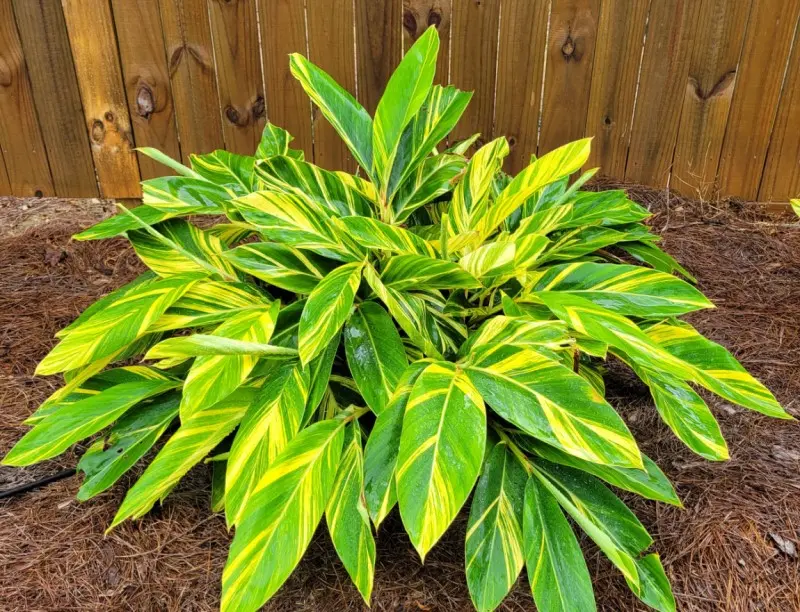
Variegated Ginger
$0.00Add to Lawn3'-6'Full shadePartial shadeNot deer resistantVariegated Ginger (Alpinia zerumbet ‘Variegata’), also known as Shell Ginger, is a tropical perennial prized for its striking, variegated foliage and lush, bold presence. Native to East Asia, this ginger species features large, lance-shaped leaves with dramatic green and yellow striping that brightens up garden spaces year-round. In optimal conditions, it produces drooping clusters of shell-like, fragrant white and pink flowers, typically in late spring to early summer. The flowers’ unique shape gives this plant its common name, resembling small seashells with hints of pink and yellow inside. Variegated Ginger typically grows to about 4 to 6 feet tall and wide, making it ideal for filling large spaces or creating a tropical privacy screen. This plant thrives in partial shade to full shade and performs best in USDA zones 8-11. It prefers consistently moist, well-draining soil enriched with organic matter, though it can tolerate brief dry periods once established. While Variegated Ginger is frost-sensitive, it often bounces back in spring after winter dieback in cooler climates. Low-maintenance and relatively pest-resistant, Variegated Ginger benefits from occasional pruning to remove spent blooms or damaged foliage, which encourages fresh growth and keeps it looking vibrant. Its lush, tropical appeal and bold variegation make it a stunning addition to shaded garden beds, borders, or as a container plant on patios. Variegated Ginger adds warmth, texture, and an exotic touch to landscapes, thriving in both tropical and subtropical garden designs. -
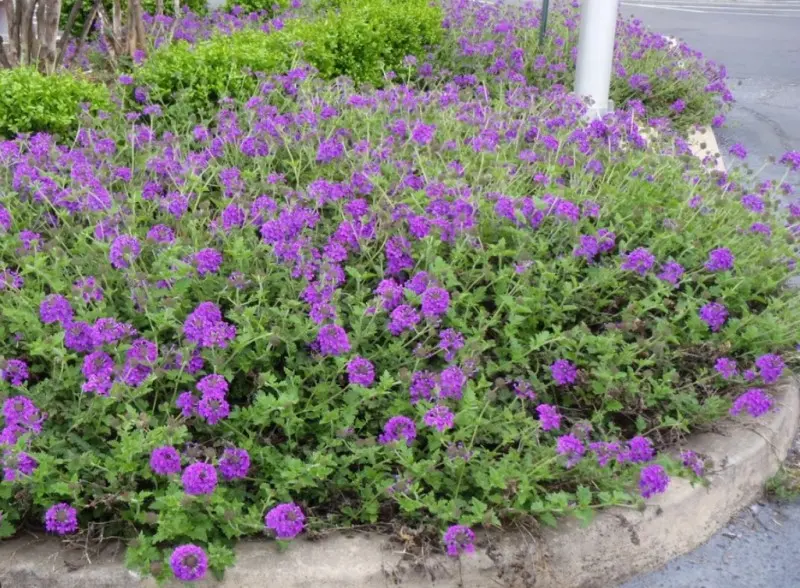
Verbena
$0.00Add to Lawn1'-2'Full Sun-Deer resistantVerbena (Verbena spp.) is a versatile flowering plant valued for its clusters of small, vibrant blooms that appear in colors such as purple, pink, red, white, and blue. Known for its extended blooming period, Verbena adds consistent color to gardens from late spring through fall. This hardy perennial, native to the Americas, is popular in both garden beds and containers, where its trailing or mounding habit can create lush displays of color. Verbena varieties range in size from low-growing ground covers to taller, upright types, making it adaptable for various landscape uses. Verbena thrives in full sun and is hardy in USDA zones 7-11, though it is often grown as an annual in cooler climates. It requires well-draining soil and benefits from regular watering, especially during dry spells, though it is moderately drought-tolerant once established. To encourage continuous blooms, occasional deadheading or trimming is beneficial, as it prevents the plant from becoming leggy and promotes new growth. Ideal for borders, hanging baskets, rock gardens, and pollinator gardens, Verbena attracts bees, butterflies, and other beneficial insects. Its easy-care nature, resistance to pests and diseases, and continuous flowering make Verbena a favorite for adding lasting color and charm to sunny spots in the garden. Whether used as ground cover, a spiller in container arrangements, or a colorful filler in garden beds, Verbena brings vibrant, low-maintenance beauty to any landscape.

